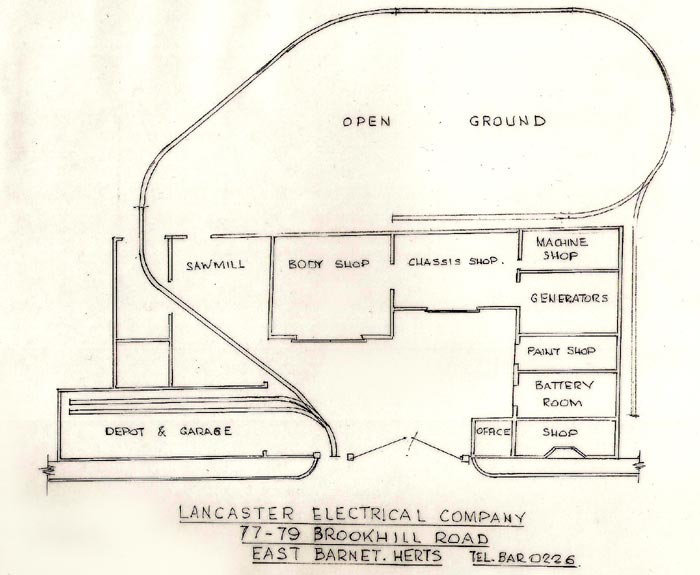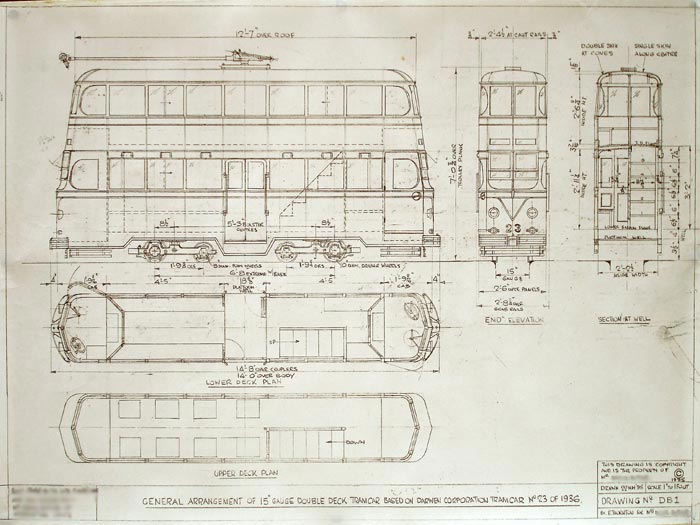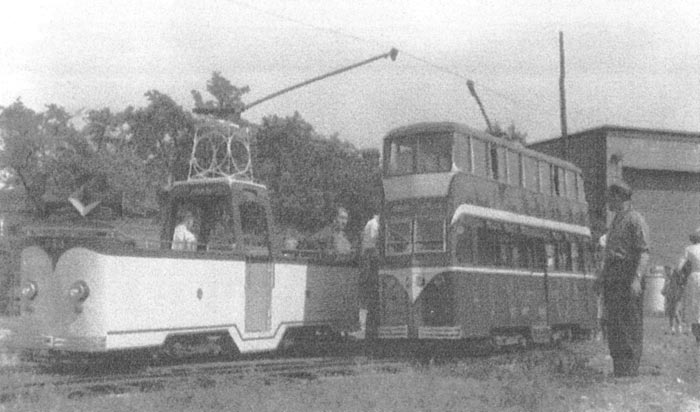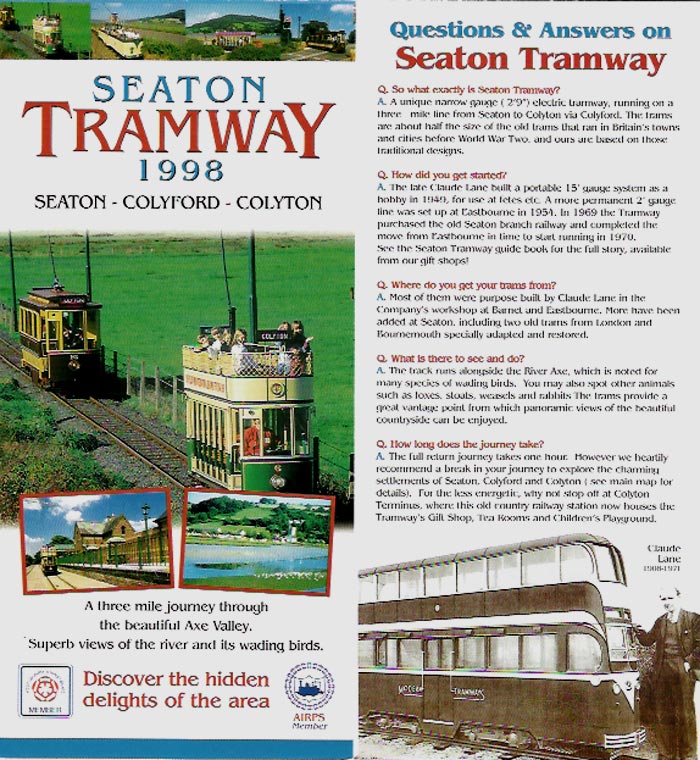
This website is about a man's dream that became reality. The Story of Modern Tramways Miniature Tramcar No 23. Claude Lane trained as an electrical and mechanical engineer with Blackstone Oil Engineering Company, of Stanford in Lincolnshire and later set up his own business in small premises in Lancaster Road, New Barnet, North London in 1931. The company was registered as The Lancaster Electrical Company, carrying out electric motor rewinds, generator repairs, traction battery repairs and replacements. As the company expanded bigger premises became a number one priority. This led to a move to Brookhill Road, Barnet, enabling Claude Lane to venture in to production of Light Electric Traction Vehicles for industry, including milk floats, delivery vans, trucks and mini people carriers. With war immanent at the end of the 1930's, petrol and oil were rationed, making the electric vehicle a more practical proposition. At the same time Claude Lane ventured in to the radio trade. He opened the shop at the front of the building selling radios, accessories, electrical installations and accumulator recharging, the latter being in great demand due the high number of houses in the area still without electricity and reliant on gas lighting. By 1945, petrol and oil were starting to become more available; this led to the decline of the electric vehicle. Also the larger manufacturers were becoming extremely competitive, chasing fewer orders. Claude Lane now had more time on his hands during the summer so he decided to apply for a summer season job driving tramcars in Blackpool – a life-long interest. During the years he worked there, he drove nearly every type of car in the fleet and did many special tours for transport and tramway groups. At the end of the 1948 season Claude Lane was driving home to Barnet, a long way without the M1 motorway. During the journey he made a detour via the Welsh Coast, calling on a few friends at the Llandudno and Colwyn Bay Tramway. This gave him time to think about what he was going to do during the winter months. With all the resources available to him at Barnet he decided that he would build a miniature tramway for his own amusement, so as soon as he arrived back at the works he set too to design a small tramcar. The prototype chosen was a scaled down version of an ex Darwen Corporation Streamliner then operating on the Llandudno and Colwyn Bay Tramway with a fleet No 23. Two sets of plans were sketched out, one for the tram that had to be on narrow gauge track and the other was the track plan. It was decided that the tram would operate on 15” gauge trucks so that it would enable the vehicle to negotiate the sharp bends through the factory buildings. The track plan had to incorporate a tram shed, a starting point at the gates and be able to travel through the works so as to gain access to the large piece of ground at the back. (See track plan at Barnet Works)
On the 3 rd October 1948 Claude Lane was ready to start the construction of his miniature tramcar No23 - Modern Tramways was born. Instructions were given to the sawmill, the joiners shop, and the chassis shop for work to commence. By the end of the third week the construction of the body was well underway.
One evening a young boy was on his way home from school and was passing Barnet Works, he noticed that the large doors had been left part open and the light was shining out of the opening. To his amazement he could see a small tramcar being constructed. This needed closer investigation, but as he approached the entrance he felt a large hand firmly land on the back of his neck and a stern voice say “WHAT DO YOU THINK YOU ARE DOING?” The young man explained that he was very interested in trams and that his grandfather had been a driver with Metropolitan Electric Tramways in London. Claude Lane realising the young man was genuinely interested, so he said get here for 9am on Saturday morning, I will give you a Saturday job and you can help me build it. As the young man turned to make his way home, Claude Lane asked him his name. The young man replied “Allan Gardner, Sir.” Work progressed and the castings for the maximum traction bogies arrived, this meant that Claude Lane could start to construct the bogies and fit the two 1-horse power 60-volt electric motors. The controllers were manufactured by SHARP and modified by Claude Lane to look like tram controllers, this also required the casting of long type tram control handles. The resistances had to be mounted under the driver cab floor, just above the life tray as space was at a premium. The staircase measuring only 11 ¾” wide was fitted and the top deck was completed with its flip over seating. With the windows and windscreens fitted and paintwork gleaming No23 was ready to take to the rails
The construction of track and overhead was also progressing at a good pace. Track was laid from the front gate in Brookhill Road to the factory with a set of left hand points situated halfway, leading off to the garage that housed the delivery vans. This was to double up as a tram shed. The track was extended out of the works across and around the field at the back, terminating outside the body shop windows. The track was later extended with a siding down the right hand side of the works for loading and unloading from a trailer. Finally with everything in place and the power switched on it was time to put the miniature tramcar through its paces. All went well with only a few adjustments to the overhead. After only a few days a couple of local children discovered the tram and the word travelled quickly. By the following Saturday crowds of children and some parents started to gather at the main gate in the hope that they may see this little tram driving out of the shed. Claude Lane decided that it was better to see a tram full of passengers so he invited some of the children to have a free ride. This went on all afternoon with rides through the works and back. So with No23 fully tested the little tramcar was ready for passenger service. As the weeks went by, requests started to come in from around the area for Mr Lane to bring his tramcar to their garden parties or fetes. This would be no easy task but Claude Lane took it as a challenge. So he decided to build some portable track in sections that would assemble in the form of a figure 9. The overhead poles to carry the live trolley wire would be constructed from ships boiler tubes and fitted with a clip in adaptor that would slot under the track and keep them steady. Also a new trailer was constructed to transport No23. The last problem to be solved was the fitting of a 60-volt dc supply in the middle of a field at a garden fete. The solution was parked outside the chassis shop, one of Claude Lane's Electric Delivery Vans complete with its own set of traction batteries. Claude Lane accepted his first booking for the Conservative Party Annual Fete on the 2 nd June 1949 at the grounds of Hadley House at Barnet. The night before all the track and overhead pole were loaded on to the wagon and No23 on to the trailer. The electric van was kept on a trickle charge so its batteries would be ready for a good days work. Early the next morning Claude and Allan set off with every thing in tow. As soon as they arrived Claude set off to survey the surrounding area for flat ground for the track and a tree that he could secure the overhead wire too. Once that was decided they started setting up, before the other stallholders arrived. As soon as everything was up and running the public started to arrive. Queues of passengers began to assemble at the tram stop and it was soon apparent that the little tramway was the star of the show. Further invitations started to come in from other Garden fetes and functions as far a field as Uxbridge and Hitchin.
At the Hitchin Garden Fete. 1950. With the great success of No23, Claude Lane decided to construct a replica Blackpool Open Boat type tramcar. This was influenced by the fact that No23 was only capable of carrying children, where as the Boat Car could also accommodate adults. The Boat Car was numbered 225 and was completed in spring 1950. The cars first passenger service was on Whit Saturday May 1950 and proved to be very popular with every one. At the end of the summer season Mr Lane and his team decided that single day events were too demanding considering that the track and overhead had to be installed and dismantled each time. It was decided that a more permanent venue would be the answer. One weekend in the winter of 1950 Claude Lane took a trip along the south coast and came to Hastings and discovered there was a strip of land along the promenade at St Leonard's that was not in use and would be ideal for the tramway. As soon as he arrived back at Barnet he contacted Hastings Council and started negotiations. It was finally agreed that for a trial period of one year the land from the Bathing Pool to the Marina could be leased, with a review at the end of the season. Back at Barnet Works things were under way constructing overhead equipment, maintaining the trams and placing orders for rail, as this would be a longer distance than the trams had ever run before.
No.23 - the very first tram to be built by what would become the modern day Seaton Tramway Company. Shown here with Claude Lane in the 1998 Seaton Tramway promotional brochure.
|




